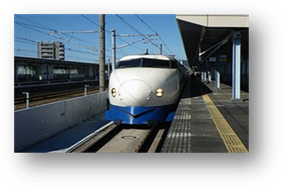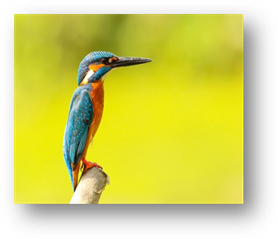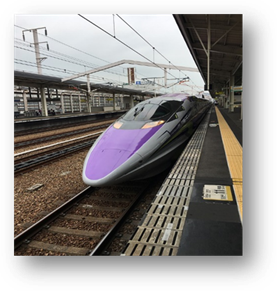|
Japan’s high-speed trains have been known from their beginning for their safety, efficiency, and comfort. However, until the late 1990s, they were also noted negatively, on one line, for the loud noise they made on exiting that line’s many tunnels. “When a train entered a tunnel, its blunt bullet-shaped nose compressed the air. When the train exited the tunnel, the compressed air expanded so rapidly it produced what is known as a tunnel boom” -- a loud disruptive noise.1

Eiji Nakatsu, Chief Engineer of the West Japan Railway Corporation needed to solve the tunnel boom problem. He was familiar with birds -- his hobby was studying them. Nakatsu and his engineers experimented by firing various shaped bullets, inspired by bird beak shapes, into a pipe until they found the shape that caused the least tunnel boom. The long tapering beak of the Kingfisher, a bird that dives quickly and quietly into water to catch fish, was found to be the shape that caused the least exist noise.

The new Kingfisher beak-shaped Shinkansen trains went into service in 1997 1, 2 -- problem solved by looking to nature.

This bird-beak-to-fast-train story nicely introduces biomimicry. Natural sciences writer Janine M. Benyus, in her book Biomimicry: Innovation Inspired by Nature,3 defines biomimicry as “a new science that studies nature’s models and then imitates or takes inspiration from these designs and processes to solve human problems…” Nature becomes a source of creative ideas, an innovation teacher.
Consider varied examples of solutions inspired by nature:
- The peristaltic pump, where liquids are squeezed in the desired direction, was inspired by the valves and chambers in animal and human hearts.4
- Seashell shapes inspired the design of the Sydney Opera House.4
- A palm tree forest inspired Santiago Calatrava, the Spanish engineer and architect, to design the columns in the Lisbon, Portugal train station – an application which illustrates the structural and aesthetic benefits of biomimicry.5

- Nature’s honeycomb objects, such as the hexagonal cellular structure within beehives, inspired the design of aircraft structural elements because of the need for a high strength-to-weight ratio.4
- Burrs that stuck to his clothes and to his dog’s coat, inspired Swiss engineer George de Mestral to create the now almost omnipresent Velcro.6
Research scientist Yoseph Bar-Cohen 4 views nature as a “giant laboratory” in which “trial and error experiments” occur within the evolutionary process. The evolutionary process occurs over a wide scale, ranging from nano and micro (e.g., bacteria) to macro and mega (e.g., whales). That process produces a myriad of results available to us for copying, adapting, and otherwise using.
Which of nature’s structures, processes, or systems might we learn from and then mimic to resolve an issue, solve a problem, or pursue an opportunity?
Cited Sources:
1) Vanderbilt, T. 2012. “Better Living Through Imitation: Biomimicry Engineers are Finding the Designs of the Future in the Greatest Field Laboratory of the Past – The Natural World,” Smithsonian, September 2012, pp. 50-53.
2) EarthSky 2012. “Sunni Robertson on How a Kingfisher Inspired a Bullet Train,” (http://earthsky.org/earth/sunni-robertson-on-how-a-kingfisher-inspired-a-bullet-train), June 29, accessed February 10, 2019.
3) Benyus, J. M. 1997. Biomimicry: Innovation Inspired by Nature, Harper Perennial, New York, NY.
4) Bar-Cohen, Y. (Editor), 2012. Biomimetics: Nature-Based Innovation, Chapter 1- “Introduction: Nature as a Source for Inspiration and Innovation,” CRC Press, Boca Raton, FL.
5) Tischler, L. 2010. “The Idea Lab at Stanford’s d.school,” FAST COMPANY.COM, May 5.
6) Bellis, M. 2018. “Who Invented Velcro?” ThoughtCo, (http://inventors.about.com/library/weekly/aa091297.htm), September 24, accessed February 10, 2019.
Image sources: Pixabay
Notes:
- Please share your use of biomimicry.
- Biomimicry is one of 20 creative-thinking methods that I include in my presentations and workshops and are described in my book, Introduction to Creativity and Innovation for Engineers.
- I welcome opportunities to speak, teach, conduct workshops, and collaborate about any aspect of helping engineers and others be even more creative and innovative. Contact me at stu-walesh@comcast.net or 219-242-1704.
Learn More About Stu Walesh | Clients Served | Testimonials & Reviews
Managing and Leading Books | Tailored Education & Training
Home | Legal Notice | Privacy Statement | Site Map
Copyright © Stuart G. Walesh Ph.D. P.E. Dist.M.ASCE
Web Site Design, Hosting & Maintenance By Catalyst Marketing / Worryfree Websites |

